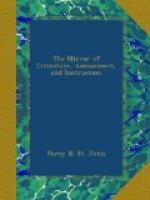August 20. Down at the Abbey this night. It would be absolute folly to note down what I saw or thought of this most remarkable monastic structure. Every album possesses it, in all the beauty of its fairy architecture; its tabernacles, its niches and canopies, and statues, pinnacles, pediments, spires, and the tracery of its vaultings.
The decorated work is most exquisitely executed. The mouldings are still so sharp, that they seem as lately from the chisel of the mason. The south transept window and door are the most perfect of the ruins. The day light of the window is twenty-four feet by sixteen, divided by four mullions. The tracery and cuspings are all of the decorated style of the Gothic. It is furnished with crotchets and creeping foliage. There are a number of niches, canopies, and tabernacles, on the south transept; and the corbels that support the statues, are carved with grotesque figures; some representing monks with cowls upon their heads, others musicians playing upon different kinds of instruments; some are most hideous to look at. Sir Walter procured casts of many of these grotesque figures, which on a visit to Abbotsford, I observed placed in the ceiling of the hall. He has clothed them in a new dress, more suited to the social scene of their present locality. But, I always ramble into the shop, when I get on architecture. Let me narrate the occurrence of this night. As I was pacing the great aisle of the abbey, a carriage drove up to the gate. “Sir Walter Scott!” said the keeper, brushing past me to receive him. A lady alighted. I heard “good night!” responded by a person in the carriage, who drove off with it. Who can this be, thought I to myself. It was dusk—the lady advanced with a stately step. I moved aside. “In these deep solitudes and awful cells!” methought I heard her say. She ascended to the bell-tower. “Who is that lady?” said I to the keeper when he entered. “That, sir,” said he, “is Mistress Hemmins, the poet writer, wha is on a visit to Maistre Lockhart, and she cam just noo in Sir Walter’s carriage, and she wants to be alane, sir, by hersel.” I took the hint, and made for the George and my glass of toddy, unwilling to deprive the world of those lays, which Melrose, the rush of the Tweed, and midnight would, no doubt, inspire in the fair authoress.




